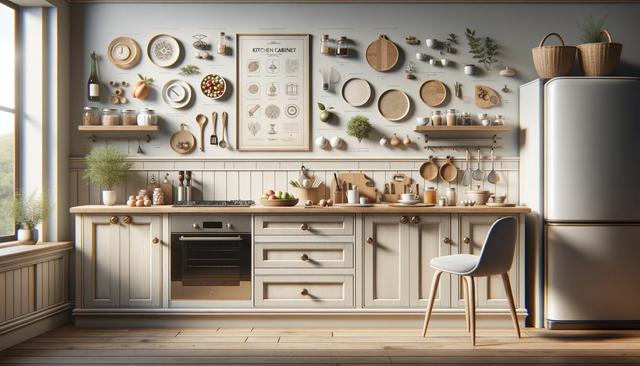Understanding the Role of Cabinet Color in Kitchen Design
Color has a powerful influence on how a kitchen feels and functions. When choosing kitchen cabinets, color selection is often one of the most impactful decisions. It not only defines the aesthetic but also affects the perception of space, light, and mood. Dark colors, for example, can create a cozy and sophisticated atmosphere but may make a small kitchen feel more compact. Lighter tones, by contrast, tend to brighten the room and create an open, airy environment. Homeowners are increasingly using color as a way to express personal style in their kitchens, moving beyond traditional wood finishes and embracing a broader spectrum of hues.
Some popular kitchen cabinet color categories include:
- Neutral shades like whites, creams, and grays for versatility and timeless appeal
- Bold tones such as navy, forest green, or deep burgundy for dramatic impact
- Pastel colors like mint, blush, or powder blue for a soft, inviting vibe
The choice of color should also consider the kitchen’s existing elements such as countertops, backsplashes, and flooring. A well-coordinated palette ensures visual harmony and enhances the overall design.
Trends in Modern Kitchen Cabinet Colors
Modern kitchen cabinetry is characterized by a shift toward more expressive and daring choices. While white remains a reliable favorite, a growing number of homeowners are leaning into darker or more vibrant hues. Matte black cabinets, for instance, offer a sleek and contemporary look that pairs well with metallic hardware and minimalist design. Earthy greens and warm terracottas are also gaining popularity, reflecting a broader trend toward nature-inspired interiors.
Two-tone cabinetry is another trend that continues to gain traction. This approach involves using different colors for upper and lower cabinets or combining contrasting finishes, such as painted wood and natural wood grain. This technique adds depth and visual interest to the kitchen while allowing for a personalized touch. Color blocking can also be used strategically to highlight certain areas of the kitchen, such as an island or pantry wall, making them focal points within the space.
These modern color trends not only align with evolving design sensibilities but also support functional improvements. For instance, darker lower cabinets can help conceal scuffs and wear, while lighter upper cabinets maintain a sense of openness.
Choosing the Right Finish for Your Cabinet Color
Beyond the color itself, the finish of the cabinet plays an important role in both the appearance and maintenance of your kitchen. Matte finishes have become increasingly common in modern design, offering a soft, understated look that resists fingerprints better than high-gloss surfaces. On the other hand, glossy finishes reflect more light and can make small kitchens appear larger, though they require more frequent cleaning to maintain their shine.
Common cabinet finishes include:
- Matte: Smooth and subtle, ideal for modern or minimalist designs
- Satin: A balanced finish with gentle sheen, offering easy maintenance
- Glossy: Bright and reflective, suitable for contemporary spaces
- Distressed or antiqued: Adds character and a vintage touch
The durability of the finish should also be considered, especially in households with high kitchen traffic. Some finishes are more resistant to moisture and stains, which is crucial in maintaining the longevity of your cabinetry. When selecting a finish, think about your lifestyle and how much upkeep you’re willing to manage.
Coordinating Cabinet Colors with Kitchen Elements
In any kitchen design, cabinets must work in harmony with other elements to create a cohesive look. This includes countertops, appliances, flooring, and walls. For example, a kitchen with cool-toned quartz countertops might pair well with soft gray or navy cabinets, while warm-toned wooden floors can be complemented by cream or sage-colored cabinetry. The key is to establish a color palette early in the planning phase and ensure that all components align with this vision.
Here are a few tips for color coordination:
- Use a color wheel to identify complementary or analogous color combinations
- Balance bold cabinet colors with neutral walls and subtle accessories
- Incorporate accent colors through hardware, lighting, or decor
Layering textures and finishes is also an effective way to add depth to your kitchen without overwhelming the space. For instance, combining matte cabinets with a glossy backsplash or pairing painted cabinetry with natural wood elements can create a dynamic and visually pleasing environment.
Making a Confident Color Decision
Choosing the right color for your kitchen cabinets can feel overwhelming, but a thoughtful approach can help simplify the process. Start by gathering inspiration from design magazines, online galleries, or showroom displays to identify colors that resonate with your personal style. From there, consider your kitchen’s size, lighting, and existing design elements. Testing out samples in your actual space is highly recommended, as colors can look very different depending on natural and artificial light conditions.
Some helpful steps to guide your decision include:
- Ordering sample doors or paint swatches to test in your kitchen
- Considering seasonal changes in lighting that may affect how colors appear
- Seeking advice from a design professional for more complex color schemes
Ultimately, the goal is to select a cabinet color that not only enhances your kitchen’s appearance but also supports the way you live and use the space. With so many modern options available, there’s ample room to create a kitchen that feels both functional and uniquely yours.
Conclusion: Elevate Your Kitchen with Thoughtful Cabinet Choices
Exploring the world of kitchen cabinet colors opens up exciting possibilities for refreshing one of the most important spaces in your home. Whether you gravitate toward timeless neutrals or bold contemporary hues, modern cabinet options provide the flexibility to express your style while enhancing functionality. By considering finish types, coordinating elements, and the impact of color on space and mood, you can make informed decisions that elevate your kitchen’s design. Investing in updated cabinetry isn’t just about aesthetics—it’s about creating an environment that brings comfort, efficiency, and joy to everyday cooking and gathering.




Leave a Reply